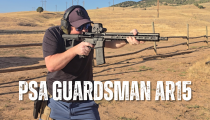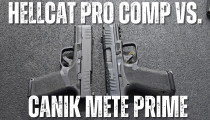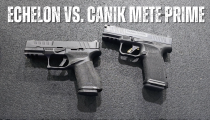Glock 19 Gen 5 vs. Smith & Wesson M&P 2.0
Glock 19 Gen 5 here: https://alnk.to/58squcO
Smith & Wesson M&P 2.0 here: https://alnk.to/cHP0Fl5
Glock 19 Gen 5 vs. Smith & Wesson M&P 2.0: A Detailed Comparison
The Glock 19 Gen 5 and Smith & Wesson M&P 2.0 are two of the most popular 9mm striker-fired pistols on the market, both widely respected for their reliability, versatility, and performance in concealed carry, home defense, and law enforcement applications. Choosing between these two can be challenging, as each offers distinct features tailored to different preferences. This article compares the Glock 19 Gen 5 and the Smith & Wesson M&P 2.0 (focusing on the compact 4.0″ model for a fair comparison), examining their design, ergonomics, performance, and more to help you decide which is best for your needs.
Background and History
Glock 19 Gen 5
Introduced in 1988 as a compact version of the Glock 17, the Glock 19 has become a benchmark for polymer-framed pistols. The Gen 5, released in 2017, refines the platform with modern updates like an optics-ready slide option, no finger grooves, and an ambidextrous slide stop. Known for its simplicity and reliability, the Glock 19 has a strong reputation in law enforcement and civilian self-defense, with a design that prioritizes function.
Smith & Wesson M&P 2.0
The Smith & Wesson M&P (Military & Police) series debuted in 2005 to compete with Glock, offering a polymer-framed, striker-fired alternative. The M&P 2.0, launched in 2017, improved upon the original with a lighter trigger, steel frame insert for rigidity, and enhanced ergonomics. The compact 4.0″ model matches the Glock 19’s size profile, making it a direct competitor for concealed carry and duty use.
Design and Specifications
Size and Dimensions
Both pistols are compact 9mm handguns designed for concealability and versatility. The Glock 19 Gen 5 has a 4.02-inch barrel, an overall length of 7.28 inches, and weighs approximately 23.6 ounces unloaded. The M&P 2.0 Compact (4.0″ model) features a 4.0-inch barrel, a slightly longer 7.3-inch overall length, and a weight of about 24.7 ounces. Their grip lengths and magazine capacities (15+1 rounds standard) are nearly identical, making them equally suitable for concealed carry.
Materials and Build
Both firearms use polymer frames with metal slides, but their construction differs slightly. The Glock 19 Gen 5 employs a durable finish on its slide for corrosion resistance, with a stainless-steel barrel featuring polygonal rifling for higher muzzle velocity but slightly less accuracy with lead bullets. The M&P 2.0 uses a stainless-steel barrel and slide with a corrosion-resistant finish, and its steel frame insert enhances rigidity and recoil management. The M&P’s slide rails are pinned, while Glock’s are molded into the frame, making Glock’s design simpler but less serviceable if rails are damaged.
Ergonomics and Handling
Grip and Controls
The Glock 19 Gen 5 eliminates the finger grooves of earlier generations, offering a smoother grip that accommodates various hand sizes. It includes interchangeable backstraps to adjust trigger reach. However, its grip angle may feel less natural for some shooters. The M&P 2.0 is often praised for its ergonomic grip, which fills the hand more comfortably and has a more intuitive pointing angle. It also features interchangeable backstraps (small, medium, large) that install easily, compared to the Glock’s more involved system. The M&P’s grip texture is more aggressive, aiding control but potentially abrasive during extended carry.
The M&P 2.0 offers ambidextrous slide stops and an optional thumb safety, appealing to users who prefer manual safeties or left-handed operation. The Glock 19 Gen 5 has an ambidextrous slide stop but lacks a thumb safety, relying on its trigger safety system. Both have accessible magazine releases, though users with smaller hands may find them slightly challenging.
Sights
The Glock 19 Gen 5 comes with basic polymer sights: a white dot front and a U-notch rear, which are durable but not glow-in-the-dark. Upgrading to aftermarket night sights is common. The M&P 2.0 features three-dot white sights that are slightly taller, aiding co-witnessing with optics, and are generally considered superior out of the box. Both pistols offer optics-ready variants, with the Glock’s system supporting a wide range of red dot sights, while the M&P’s optics-ready slide is equally versatile.
Performance
Trigger
Trigger feel is a significant differentiator. The Glock 19 Gen 5 has a trigger pull around 5.5 pounds with a rolling break, improved over earlier generations but often described as spongy. Aftermarket upgrades are popular but don’t drastically alter its character. The M&P 2.0’s trigger is lighter, around 4.5 pounds, and crisper, with a flat-face design in some models that many shooters find more precise. The M&P’s trigger also has greater upgrade potential, achieving high quality with aftermarket options. However, some users note the M&P’s hinged trigger design can feel less refined without upgrades.
Accuracy and Recoil
Both pistols are highly accurate for defensive purposes, with low bore axes reducing muzzle flip. The M&P 2.0’s steel frame insert provides a smoother recoil impulse, and some shooters report slightly tighter groups compared to the Glock. However, accuracy depends heavily on the shooter, and both guns are comparable in mass-produced precision. The Glock’s polygonal rifling may offer a slight velocity advantage, but its accuracy can suffer with lead bullets compared to the M&P’s traditional rifling.
Reliability
Both the Glock 19 Gen 5 and M&P 2.0 are renowned for their reliability, with proven track records in law enforcement and civilian use. Glocks have a longer history and are known for functioning in harsh conditions. The M&P 2.0 has matched this reliability in testing, with users reporting thousands of rounds without failures. Rare issues with earlier models have been resolved in these versions. The choice often comes down to personal trust in each brand’s legacy.
Modularity and Aftermarket Support
The Glock 19 Gen 5 excels in modularity, with extensive aftermarket support for triggers, sights, slides, and more, thanks to its long market presence. Its optics-ready system simplifies mounting, and high-capacity magazines are available. The M&P 2.0 has improved aftermarket support compared to its predecessor, with options for triggers, optics, and holsters, but it lags behind Glock in variety. The M&P’s maximum magazine capacity is slightly lower than Glock’s offerings.
Disassembly is another difference. The M&P 2.0’s takedown system doesn’t require pulling the trigger, which some consider safer. Glock’s disassembly, while simple, involves pulling the trigger, which may concern some users.
Price and Value
The Glock 19 Gen 5 typically retails around $540-$620, while the M&P 2.0 Compact is often slightly cheaper, around $370-$550. The M&P’s lower price, better stock trigger, and ergonomics make it a strong value proposition, but Glock’s superior aftermarket support and reputation may justify the premium for some.
User Feedback and Real-World Experience
Glock fans praise its simplicity, reliability, and aftermarket ecosystem, often likening it to a dependable workhorse. M&P users prefer its ergonomics, softer recoil, and trigger, with many reporting better natural shooting accuracy. Some shooters note tighter groups with the M&P at short ranges, citing less muzzle flip, while others prefer the Glock’s trigger wall for precision. Both pistols have loyal followings, and testing at a range is often recommended to determine fit.
Which Is Better?
The Glock 19 Gen 5 and Smith & Wesson M&P 2.0 Compact are remarkably similar in size, capacity, and reliability, making the choice subjective. Choose the Glock 19 Gen 5 if you prioritize unmatched aftermarket support, a proven track record, and simplicity. Its optics-ready variant and extensive magazine options make it ideal for customization. Opt for the M&P 2.0 Compact if you value superior ergonomics, a crisper trigger, and a lower price point. Its optional thumb safety and smoother recoil appeal to shooters who prioritize comfort and control.
Ultimately, both are excellent firearms, and the best way to decide is to shoot them at a range. Personal factors like hand size, shooting style, and intended use (concealed carry, home defense, or duty) will tip the scales. Whichever you choose, you’re getting a reliable, high-quality pistol that won’t let you down when it matters most.










